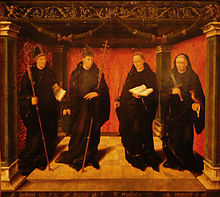Adalbert of Egmond
| Saint Adalbert of Egmond | |
|---|---|

Painting of Saints Bonifatius, Gregorius, Adelbert, and priest Jeroen van Noordwijk, by Jan Joesten van Hillegom, 1530
|
|
| Born | Northumbria |
| Died | 8th century Egmond |
| Venerated in |
Anglican Communion Roman Catholic Church Eastern Orthodox Church |
| Canonized | Pre-Congregation |
| Feast | June 25 |
Saint Adalbert of Egmond (also called Adelbert of Egmond) (died c. 710 in Egmond) was a Northumbrian Anglo-Saxon missionary. He was one of Saint Willibrord's companions in preaching the gospel in Holland and Frisia.
The Life of Adalbert is not rich in fact. He is said to have been born in Northumbria, a member of the Northumbrian royal family. According to some sources, to have been first a monk at the Rath Melsigi) and to have studied in Ireland with Egbert. He then went in c 690 to assist Saint Willibrord (who had also been at Rathmelsigi) in the mission field of Frisia, where he became associated particularly with Egmond. He was made Archdeacon of the recently founded See of Utrecht and died at Egmund about A.D. 740. He was buried there, and miracles were reported at his tomb, over which a church was built.
His continued remembrance rests largely on the foundation of the Benedictine monastery, Egmond Abbey, the first in the country, some two hundred years later by Count Dirk I of West Frisia (or Holland), of which Adalbert was made the patron. The Vita was not commissioned until the 990s, which presumably accounts for its lack of facts. Adalbert's relics were translated to the newly built abbey (initially a nunnery) for veneration. After the Reformation and the destruction of the abbey, they were preserved in Haarlem. The cult was reinstated when the abbey was re-founded in 1923, and the relics were returned there in 1984. The saint's skull, painstakingly restored, is also preserved beneath the high altar. His feast day is 25 June.
...
Wikipedia
